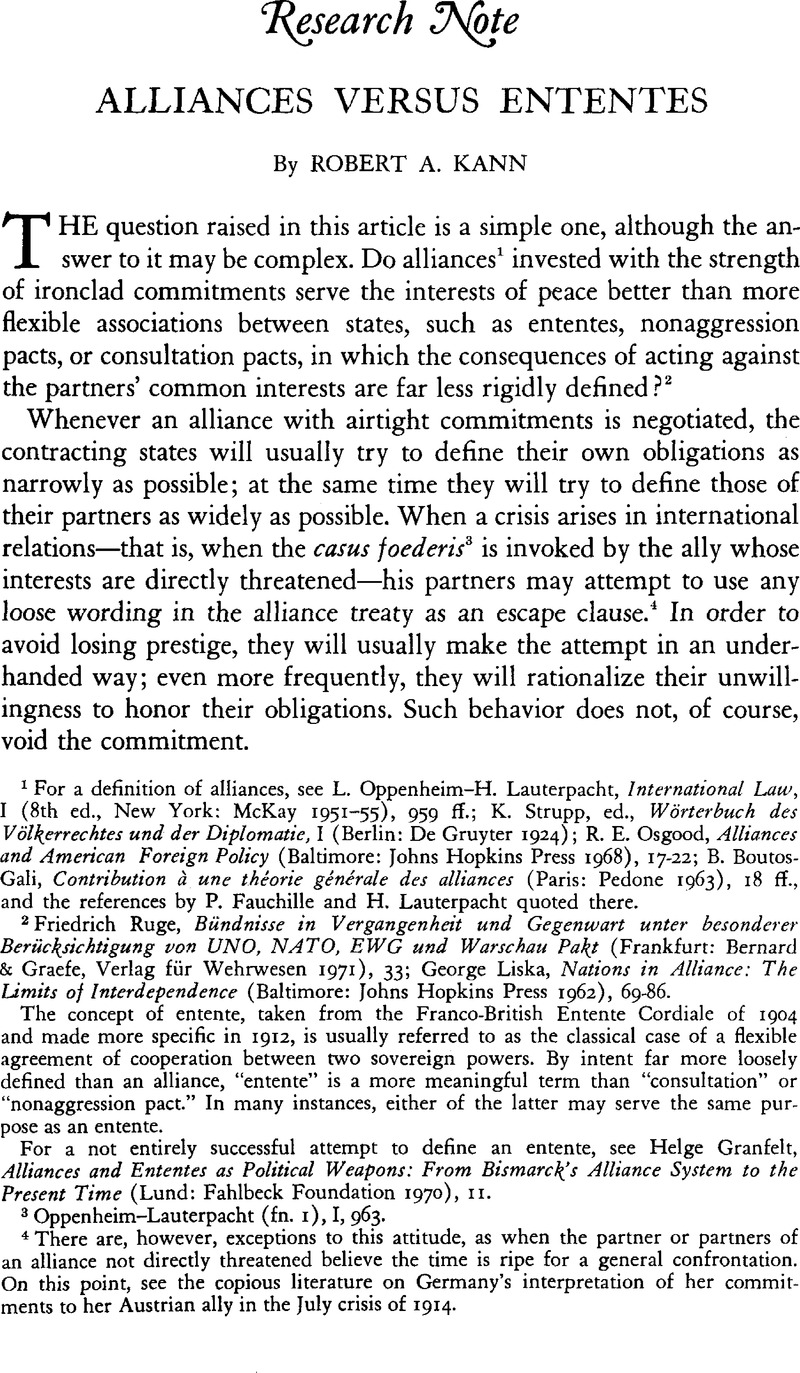Article contents
Alliances Versus Ententes
Published online by Cambridge University Press: 18 July 2011
Abstract

- Type
- Research Note
- Information
- Copyright
- Copyright © Trustees of Princeton University 1976
References
1 For a definition of alliances, see Lauterpacht, L. Oppenheim-H., International Law, I (8th ed., New York: McKay 1951-1955), 959 ff.Google Scholar; Strupp, K., ed., Wö'rterbuch des Völkerrechtes und der Diplomatic, I (Berlin: De Gruyter 1924)Google Scholar; Osgood, R. E., Alliances and American Foreign Policy (Baltimore: Johns Hopkins Press 1968), 17–22;Google ScholarBoutos Gali, B., Contribution à une théorie générale des alliances (Paris: Pedone 1963), 18 ff.Google Scholar, and the references by P. Fauchille and H. Lauterpacht quoted there.
2 Ruge, Friedrich, Bündnisse in Vergangenheit und Gegenwart unter besonderer Berücksichtigung von UNO, NATO, EWG und Warschau Part (Frankfurt: Bernard & Graefe, Verlag fiir Wehrwesen 1971), 33Google Scholar; Liska, George, Nations in Alliance: The Limits of Interdependence (Baltimore: Johns Hopkins Press 1962), 69–86Google Scholar. The concept of entente, taken from the Franco-British Entente Cordiale of 1904 and made more specific in 1912, is usually referred to as the classical case of a flexible agreement of cooperation between two sovereign powers. By intent far more loosely defined than an alliance, “entente” is a more meaningful term than “consultation” or “nonaggression pact.” In many instances, either of the latter may serve the same purpose as an entente.
For a not entirely successful attempt to define an entente, see Granfelt, Helge, Alliances and Ententes as Political Weapons: From Bismarck's Alliance System to the Present Time (Lund: Fahlbeck Foundation 1970), 11Google Scholar.
3 Oppenheim-Lauterpacht (fn. 1), I, 963.
4 There are, however, exceptions to this attitude, as when the partner or partners of an alliance not directly threatened believe the time is ripe for a general confrontation. On this point, see the copious literature on Germany's interpretation of her commitments to her Austrian ally in the July crisis of 1914.
5 This observation refers to the whole course of this alliance from 1894 to 1914 (particularly the Russian hesitancy in the two Moroccan crises of 1905/1906 and 1911 and the French faltering in the Bosnian annexation crisis of 1908/1909). Mutual obligations were eventually met by both powers in August 1914.
6 Ruge(fn. 2), 33-35, 70.
7 Taylor, A. J. P., The Struggle for Mastery in Europe 1848-1918 (Oxford: Clarendon Press 1965), 412–47Google Scholar.
8 This kind of diplomacy is discussed in Immich, Max, Geschichte des europäischen Staatensystems von 1660 bis 1789 (Munich-Berlin: Oldenbourg 1905)Google Scholar; see in particular 254-55 and 344-49. Also see Edmond Préclin, with the collaboration of Tapie, Victor L., Le XVIII siècle, I, La France et le monde de 1715 à 1789 (Paris: Presses Universitaires de France 1952), 49–93, 456-78Google Scholar.
9 See, for instance, Osgood (fn. 1), 19-21, 60-115 passim; Boutos-Gali (fn. 1), 18 ff.; Friedmann, Julian R., Bladen, Christopher, and Rosen, Steven, eds., Alliance in International Politics (Boston: Allyn and Bacon 1970), Introduction byGoogle Scholar J. R. Friedmann, 5, and “Alliances” by Hans J. Morgenthau, 80-92.
10 See also Kissinger, Henry A., A World Restored: Metternich, Castlereagh, and the Problems of Peace 1812-1822 (Boston: Houghton Mifflin 1957), 306–310Google Scholar.
11 There also exists an in-between category, the public alliance in which only specific clauses are secret. An example is the Plombières agreement between Napoleon III and Cavour in 1858, which was a secret part of the generally known French-Piedmontese alliance of 1859. The Prussian-Italian alliance of 1866 is another example: it secretly stipulated a time limit of three months within which it would become operative. Meanwhile the existence of the alliance itself, though not proclaimed, was definitely assumed by Austria. After 1918, such mixed, partly public, partly secret alliances would have seemed to the general public to be even more deceptive than outright secret alliances.
12 One may be able to argue that the British-French naval understanding prior to World War I concerning the concentration of the bulk of the British Navy in the North Sea and the French Navy in the Mediterranean represented a British moral commitment; it is certain that it did not represent a legal one. That assumption was ruled out by the exchange of letters between Sir Edward Grey, the British Foreign Secretary, and Paul Cambon, the French Ambassador, on November 22 and 23, 1912. See also Fay, S. B., The Origin of the World War, I (2d rev. ed.; New York: Macmillan 1938), 192–213;Google ScholarSchuman, Frederick L., War and Diplomacy in the French Republic (New York: Whittlesey House 1931), 173–94Google Scholar. There were, of course, exceptions to the rule of the declining momentum of secrecy, particularly in regard to Italian diplomacy; to take just one example, the secret treaty of London of April 26, 1915, between Italy and the Entente Powers was concluded at a time when the Triple Alliance treaty with Germany and Austria was nominally still in force.
13 See the literature cited in fn. 2.
14 The Franco-Italian understandings of 1902, which ran counter to both the spirit and the letter of Italy's alliance with the Central Powers and the agreement of Racconigi with Russia of 1909, ought to be mentioned here. In these cases one can justly speak of ententes which were meant to weaken Italy's obligations as an ally and to offer her the opportunity to switch sides in case of necessity.
15 This was technically a system of mutual international guarantees; but in certain contingencies, such as the arbitrary remilitarization of the Rhineland, it was meant to stand for an alliance system as well.
16 It is of course true that neither the British-German naval agreement of 1935 nor the German-Polish nonaggression pact of 1934 represented alliances, but they were nevertheless binding agreements of sorts. Both agreements were denounced by Hitler in a Reichstag speech of April 28, 1939.
17 Osgood (fn. i), 2I.
18 Ibid., 21 ff.
- 19
- Cited by




